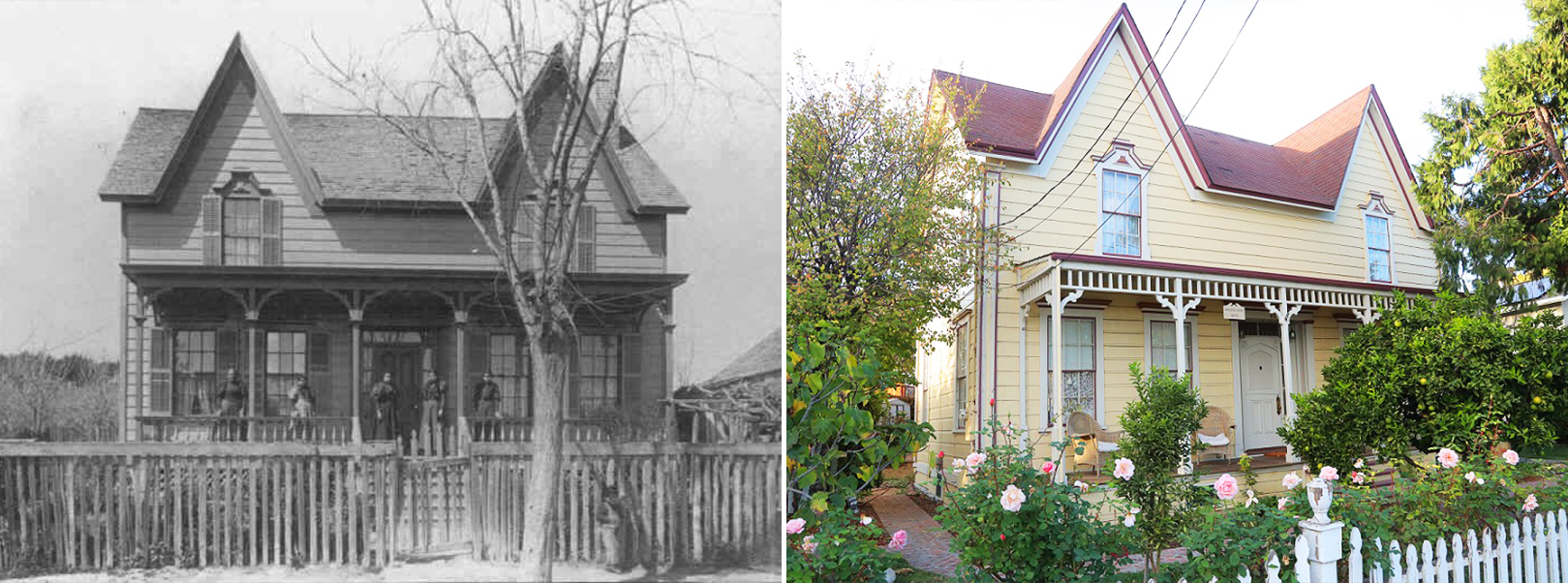Marentis House
This two-story Gothic Revival style twin gabled home exemplifies construction that was prevalent in rural California in the 1870’s. Construction of the home was commissioned by Pedro Marentis and the design was created by architect George Chalmers. The home was constructed in 1874 by local builder Thomas Burmingham who constructed at least one other similar home in San Juan Bautista at the corner of Highway 156 and The Alameda. Heritage roses in the garden still remain from those early times.
 The dwelling was designed as a home for a large number of people as Claudia Estrada and Pedro Marentis, who were married at Mission San Juan Bautista in 1857, had 14 children. The upstairs consisted of two large rooms, one for boys and one for girls, and was divided by a long hallway. Downstairs was a large sala, a parlor, another bedroom and a large family-style kitchen.
The dwelling was designed as a home for a large number of people as Claudia Estrada and Pedro Marentis, who were married at Mission San Juan Bautista in 1857, had 14 children. The upstairs consisted of two large rooms, one for boys and one for girls, and was divided by a long hallway. Downstairs was a large sala, a parlor, another bedroom and a large family-style kitchen.
Entirely constructed of heart redwood, the house is a single wall wood frame of vertical rough sawn boards that rested on mud sills. The ceilings upstairs are 12 feet high and downstairs they are 10 feet in height, and are made of 1’x 4′ tongue-and-groove planks. Hood moldings over the doorways and windows add interesting detail to the building’s exterior.
John (Johnny) Marentis, the youngest son who was born in 1888, inherited the house after both of his parents passed away. He was the City Treasurer of San Juan for 51 years, the longest serving elected official in the state. When Johnny was a child the population of San Juan was about 600, half of which were Spanish and many were Indians.
Johnny worked at the McAbee Ranch driving cattle for Henry Miller, and also worked haying for Ferry Morse Seed Company. He and a brother would play violin and guitar for friends who gathered in the sala of the home. His mother was known for her enchiladas which were hungrily consumed by the town folk and were served in the Plaza Hotel. She would even pack some on buses for customers from San Francisco.
Eventually Johnny decided to become a butcher, learning the trade from Antoine Taix at his butcher shop at 303 Third Street where Johnny worked for 12 years. He then opened The San Juan Meat Market with Jake Beuttler on 3rd Street, which was in business for 26 years. In 1944 Johnny married Lucille Mary Herman at Mission San Juan Bautista. Johnny was always active in the life of San Juan. He was a volunteer firemen and police deputy constable for C.C. Zanetta and Bob Baccala. Until age 85 he rode horseback to Fremont Peak for the annual flag raising ceremony along with the Flint’s, Abbe’s and Anzar’s. He took part in the Fiestas and rodeo by leading the parade until he was no longer able to ride.
The home was purchased from the Court as an investment as Johnny had died intestate. It was in a much deteriorated condition and was sold to the Gilsenan/Fritch’s who over a six-year period completed a Federally certified historic restoration in the 1980’s. The home was placed on the National Register of Historic Places in 1984. Currently it is maintained as a residence.
Supported By 24x7 WP Support Desk
